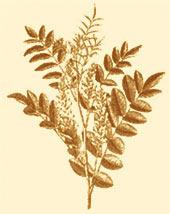
Liquorice
€ Low price
Known in antiquity as the Glukurrhiza for the Greeks and Romans Liquiritia for the virtues of this plant through the ages.
In Népour, Babylonian Empire capitale, excavations have uncovered a version of the genesis dating from 7000 years BC. It called maceration licorice cinnamon and anise to fight against the plague. In "From Plantarium Historica", it is found under the name "sweet root" and mixed with honey, it heals ulcers, improves asthma, dry coughs and prevents thirst.
In Rome, doctors prescribed this root against anemia and the soldiers of Alexander and Caesar used it regularly to relieve stomach cramps. Closer to home, the Middle Ages took her into the composition of remedies for sore throat, cough or upset stomach.
Thus, in 1440, Montpellier, land and trade schools, imported thanks to Jacques Coeur, across the Mediterranean and East liquorice root.
Nowadays, its use is intended in large part to the confectionery industry.
In Népour, Babylonian Empire capitale, excavations have uncovered a version of the genesis dating from 7000 years BC. It called maceration licorice cinnamon and anise to fight against the plague. In "From Plantarium Historica", it is found under the name "sweet root" and mixed with honey, it heals ulcers, improves asthma, dry coughs and prevents thirst.
In Rome, doctors prescribed this root against anemia and the soldiers of Alexander and Caesar used it regularly to relieve stomach cramps. Closer to home, the Middle Ages took her into the composition of remedies for sore throat, cough or upset stomach.
Thus, in 1440, Montpellier, land and trade schools, imported thanks to Jacques Coeur, across the Mediterranean and East liquorice root.
Nowadays, its use is intended in large part to the confectionery industry.
Supplier


Company

Website
 France
France
Country
Product details
Place of processing
-
Origin of main ingredient

Origin of main ingredient

Packaging formats

Packaging

Composition


